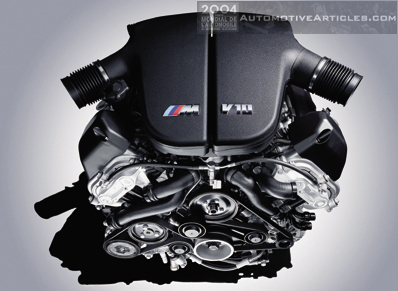|
From AutomotiveArticles.com 2004 Paris Motor Show
With a big old V10, that’s how! You also get controversial American designer Chris Bangle’s team to add a bit of lipstick to an already debate-provoking design. But screw what it looks like, let’s talk power. The new M5, according to the company, is the most powerful production vehicle in the BMW lineup. Considering this is a family of vehicles that don’t exactly have any problems in the power department, to be at the top of this gene pool is quite a feat. How much so, you ask? Think 507hp and 384 ft-lbs of torque out of this 5.0L beast with an 8,250rpm redline. That’s an increase in performance by over 25%, not to mention that this V10 tops the oh-so-wonderful 100hp per liter mark.
The exhaust system is made of seamless stainless steel with a dual-flow design all the way to the mufflers, where they exit out through M-trademark four tailpipes. In the United States, the M5 is expected to meet LEV2 emissions standards. Ionic current technology is used by the engine management unit to detect engine knock, misfiring, and combustion misses. Essentially, the system uses the spark plug as an actuator for the ignition and as a sensor for monitoring the combustion process.
Replacing the previous M5’s six-speed manual will be an all-new seven-speed (the world’s first) sequential gearbox, aka SMG. Considering the V10’s high-revving nature, the short-spaced shift times should allow the driver to wring the most out of this sedan’s 8,250rpm redline. This being an SMG transmission, an automatic-shift feature will be available for those times when you’re sitting on the 10 freeway, crawling your way into Los Angeles (which Southern Californians know is, basically, every day). As good as the SMG may be, you can imagine some diehards are lamenting the loss of a true manual transmission. However, when this beast goes from 0-62mph in 4.7 seconds (according to BMW), who really gives a damn? The 124mph mark is reached in a very quick 15 seconds while the top speed is an electronically-limited 155mph. BMW boasts the M5 could top out at 205mph if it wasn’t for the damn computer. Paging big, angry mob: Bill Gates needs you in room 5. Thanks.
For starters, there’s an exclusive variable, torque-sensing differential lock for optimum traction, especially coming out of corners. BMW’s Dynamic Stability Control (DSC) comes with two selectable driving styles: one similar to the typical 5-series, and the M Dynamic Mode that allows for sporting maneuvers while still standing by to save your sorry ass should things get a little out of control. Of course, DSC can also be deactivated at the press of a button. Likewise, the M5’s Electronic Damper Control (EDC) allows the driver to select three levels of electronic suspension tuning (comfort, normal, sport) – no longer does buying a sports car mean a constant kidney pounding ride. Unless, of course, you like that kind of stuff. The large brakes and twin-piston sliding calipers (similar to those in the 7-series) are expected to bring the M5 from 62mph to 0 in under 36 meters.
Whatever you think about Chris Bangle, iDrive, and the rest of the “new” BMW lineup, the M5 is still a force to be reckoned with. To some, it may not have that classically aggressive look of past, but it’s certainly got the balls to back up its unique looks. I started this article writing about a letter and a number. I’ll end it with another letter and two more numbers. V10. That’s all that matters. © Copyright 2004 by AutomotiveArticles.com |



